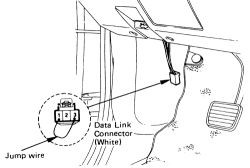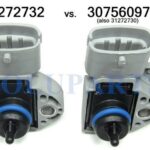Navigating vehicle diagnostics can seem complex, especially when trying to locate the OBD2 port on your 1995 Isuzu Trooper. While the term OBD2 is commonly used, vehicles of this era often utilized earlier diagnostic systems. This guide will clarify where to find the diagnostic connector on your 1995 Trooper and how to access the trouble codes, ensuring you can effectively troubleshoot your vehicle.
Identifying the Diagnostic Connector Location on a 1995 Isuzu Trooper
Depending on the specific configuration of your 1995 Isuzu Trooper, you might encounter different types of diagnostic connectors. Understanding these variations is crucial for accessing your vehicle’s diagnostic information. Here are the potential locations and connector types you might find:
One common location for the diagnostic connector is under the dashboard, typically on the driver’s side. You might find a 12-cavity ALDL (Assembly Line Diagnostic Link) connector.
Another possible location is a 3-cavity DLC (Diagnostic Link Connector), also usually found under the dash on the driver’s side.
 3-cavity DLC connector location for reading diagnostic information in 95 Trooper
3-cavity DLC connector location for reading diagnostic information in 95 Trooper
In some 1995 Trooper models, you might find separate white and black diagnostic terminals. These are often located under the instrument panel, near the left kick panel on the driver’s side.
Reading Diagnostic Trouble Codes on Your 1995 Trooper
Once you have located the diagnostic connector, you can proceed to read the trouble codes. The method varies slightly depending on the type of connector your vehicle is equipped with:
For models with a 12-cavity ALDL connector:
- Locate terminal B on the ALDL connector. Grounding this terminal is necessary to initiate code reading. The easiest way to ground it is by connecting it to terminal A, which is an internal ECM ground. Terminal A is typically to the right of terminal B on the top row of the connector.
For models with a 3-cavity DLC connector:
- Connect the two outside terminals (terminals 1 and 2) together using a jumper wire or suitable connector.
For models with white and black diagnostic terminals:
- Simply connect the white and black diagnostic terminals together.
After connecting the appropriate terminals for your connector type, follow these steps to read the codes:
- Turn the ignition switch to the ON position, but do not start the engine.
- Observe the “Service Engine Soon” or “Check Engine” light on your dashboard. It should begin to flash. If it doesn’t flash, turn the ignition OFF, remove the jumper wire, and turn the ignition back ON to ensure the bulb is working. If the light does not illuminate at all, replace the bulb and try again. If it still doesn’t light or flash after grounding the test terminal, consult a qualified technician.
- The system will typically start by flashing Code 12. This code consists of one flash, a pause, and then two flashes. Code 12 is a system acknowledgment code, indicating that the ECM (Engine Control Module) is communicating correctly and is used to initiate every diagnostic sequence. Some vehicles may also repeat Code 12 after all diagnostic codes have been sent.
- After Code 12 is transmitted three times, any stored fault codes will be flashed. Each fault code is also transmitted three times. The codes are displayed in numeric order, from the lowest to the highest.
- If no fault codes are stored, but you are experiencing a driveability or emissions problem, further diagnosis by an experienced technician is recommended.
- If one or more codes are displayed, carefully record them. Then, refer to a diagnostic code chart specific to your 1995 Isuzu Trooper to understand the meaning of each code.
- Once you have retrieved all the necessary codes or finished using a scan tool, switch the ignition OFF.
After performing repairs based on the diagnostic codes, it’s essential to clear the trouble codes and test drive the vehicle to see if any codes reappear, indicating unresolved issues. Keep in mind that disconnecting the battery on older OBD-I systems might clear codes from temporary memory, but OBD-II systems and potentially some OBD-I systems in 1995 vehicles retain codes even after battery disconnection, requiring a scan tool for clearing.
By following these steps, you can effectively locate the OBD2 port equivalent on your 1995 Isuzu Trooper and retrieve diagnostic trouble codes, aiding in the maintenance and repair of your vehicle.
